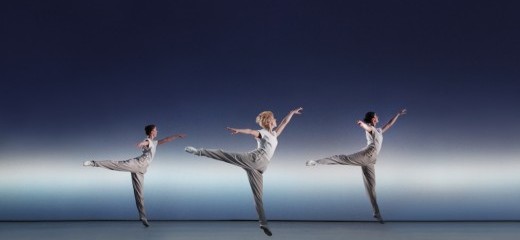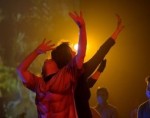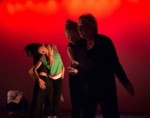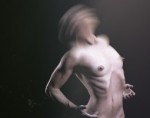
Photo: Lucie Jansch
Skipping and Slipping Through Time with Lucinda Childs
by Megan Bridge
Will. Will we. Will we get. Will we get through. Will we get through melody. Will we get through Melody Excerpt. Failing, gasping, sweating, skipping, pissing in my pants. Insisting on levity. It’s skipping for god’s sake. Dancing Lucinda Childs’s Melody Excerpt (1977) on October 4th 2013 at the soft opening of the brand new FringeArts Space was probably the most horrifying, and simultaneously elating, performance experience of my professional career as a dancer.
A week later, I’m writing this on the plane home from Los Angeles, where I went to see Einstein on the Beach on the last leg of their North American tour. (At least as of now...there are unsubstantiated rumors that performances at other venues might be added next year.) Einstein on the Beach (1976) is a four-and-a-half-hour opera with no intermission by director Robert Wilson and composer Philip Glass, with choreography by Childs.* This production has been touring since early 2012, and is the work’s third re-staging (after productions in 1984 and 1992). Long imagistic sequences unfold through series of precisely-timed movement, sound and lighting cues. Einstein’s central structuring device is to alternate between scenes differentiated as portraits, still lifes, and landscapes. Five interstitial sections, the portraits, in which the action takes place closest to the audience, are referred to as “Knee Plays,” so called because they serve as joints, linking the larger segments together. The action of the piece progresses through the still lifes, in which the stage is filled with elaborate and richly painted sets and lighting. The landscapes are where Childs’s main choreographic contributions to the work are located, standing out in high relief, as clearings in the opera’s dense texture. Referred to as Field One and Field Two, the dances are highly formalist, using space as a place to play out complex physical patterns that develop in intricate and precise relation to the musical score. Distributing a limited number of movement phrases across a certain number of bodies, Childs uses her brilliant understanding of space and the tight, repetitive, looping structure of the music to determine how those phrases interweave. The field dances are traces of a rigorous process: the choreographic playing out of possibilities.
In September 2010 in Philadelphia, an audition notice was posted by the Pew Center for Arts and Heritage for a paid workshop opportunity to study with Childs, and to work on a project reconstructing her 1977 work Interior Drama. The workshop persisted beyond its initial scope...rehearsal periods were added, we reconstructed more and more work. Childs and her rehearsal director, Ty Boomershine, returned to Philadelphia five times over the course of three years, for a total of thirteen weeks of workshop/rehearsals. The composition of the cast changed over time, as injuries or other commitments prevented dancers from returning to the project. For those who returned, the movement settled deeper into our bodies.
I’d read about Childs’s work and seen her visually compelling diagrammatic scores plenty of times over the years, starting in my days as an undergrad. OK, historically important, but too... formalist, I thought. Minimalism can be intellectually interesting, but my expressionistic lineage and aesthetic leanings made me hold these works at arm’s length. Participating in this project, though, brought home the idea that these works are a composite. Like
Einstein’s field dances, Childs’s early minimalist works are about the playing out of possibilities. The work is just as much about the process of its making as it is about the
traces left by the finished product (the performance itself, the documentation, the score). And the process is not just about Childs in her studio with dancers in the 1970s, or rolling up her sleeves and mapping out possibilities of movement at her desk as she draws her beautiful scores. It’s a contemporary process. It’s about our hours with Childs and Boomershine in the studio, our conversations over lunch breaks, the community that’s built up when a group of people throw themselves so completely into a shared task. This community is absolutely visible on stage. There is an incredible humanity to these works that comes through specifically because of their formalism. They are so challenging and require such intense concentration on the part of the performers that there is no time to “perform.” We just do. Our tension and shared focus pull the audience along with us. We breathe and the audience holds its breath. We are suspended in time. This is what artist/theorist Erin Manning refers to as “event-time...a miring in the multiplicity of nows--the now that has passed, the now that is passing, and the now that will have been, each phase of nowness contributing to the occasion at hand in a time-loop that resists the organization of experience into a linear continuum.”** Manning’s words articulate the slippery and expansive feeling of time that I experience as a performer inside
Melody Excerpt and
Interior Drama, and as a watcher in
Einstein on the Beach, too
.
“Would. Would I. Would I get. Would I get some. Would I get some wind. Would I get some wind for. Would I get some wind for the. Would I get some wind for the sailboat.” This and many other poetic texts written by Christopher Knowles, a then-thirteen-year-old autistic child, are woven throughout Einstein on the Beach. At a pre-performance talk at UCLA’s Royce Hall on Saturday October 12, Robert Wilson spoke about visiting the center where Knowles was being treated. He noticed that Knowles’s “poetry” was systematically and mathematically organized, with the words often laid out in specific visual patterns on the page. But to most people, who weren’t looking or listening very closely, it sounded like Knowles was just spouting echolalic gibberish. All of Knowles’s behaviors were being “corrected” by the institution. Wilson, on the other hand, saw something more and invited Knowles into a years-long collaborative relationship. Wilson adamantly asserts that Einstein is non-narrative. I would venture to say that it makes use of a more layered narrativity, where multiple levels of meaning are parsed experientially by the watcher. Einstein does not reward an attempt to “follow” a plot or make cognitive “sense” out of the work, but this doesn’t mean it can’t carry meaning, even narrative meaning. Childs’s field dances, like Knowles’s text and Glass’s music, are highly organized: systematic, mathematic. Meaning arises through difference and repetition. In Einstein on the Beach, Childs’s formalist field dances repeatedly stand out, clear the way, challenging us to expand our view, look again, take a breath, and then dive back in.
Back to Philly. Opening night. Five Lucinda Childs pieces were on the program. All difficult in their own ways. But Melody Excerpt we had never gotten right in rehearsal. Not once, not even in dress rehearsal. We had gotten better and better at making mistakes, at finding our way back into the structure after dropping out when we individually, or collectively, blanked on our sequences. Childs and Boomershine gave us pep talks, saying that finding our way back into the piece without stopping was the real skill, that there were always bound to be foibles and dropped sequences. The trick was to hold your own sequence...to not be too reliant on the other performers’ positions in space to determine your own. Know your sequence and execute it. The drop-outs, the crazy loops, the drop-ins, the crazier loops, the cluster-fuck, the double drop-outs, the trident. We gave names to chunks of material to orient ourselves, to give us a ground to stand on. There was no relying on muscle memory...the movement repeats the same three phrases over and over in endless permutations of the relationships of bodies in space.
When we walked on stage and the lights came up, energy was ricocheting all over that space. Can tension be explosive? Can a controlled detonation play out over the course of thirteen minutes, held in check under the careful skipping of ten feet and buoyed by 220 pairs of anxiously watching eyes? Nora Gibson corralled that crazy energy: like a cowgirl with a lasso, she stood stock still, downstage center, her back to the audience. Like every time she started dancing
Melody Excerpt, she looked around at each of us, checking to make sure we were ready. Dead silence. She began. Skipping. We nailed it.
* Robert Wilson interviewed in
Fader: "The original choreography was by Andy deGroat and was performed by nine dancers. These people also were the chorus that sang. Now we have professional singers and choreography by Lucinda Childs being performed by trained dancers. Childs choreographed both the 1984 and 1992 revivals." And the production cited here.
** Erin Manning,
Always More Than One: Individuation’s Dance (2013, Duke University Press), p. 80
Lucinda Childs: Selected Dances, 1963-78, October 4 (FringeArts Theater) & 6 (University of the Arts), 2013. No further performances.
Einstein on the Beach, October 11-13, LA Opera. No further performances.
Click here for future touring engagements.
By Megan Bridge
October 17, 2013








